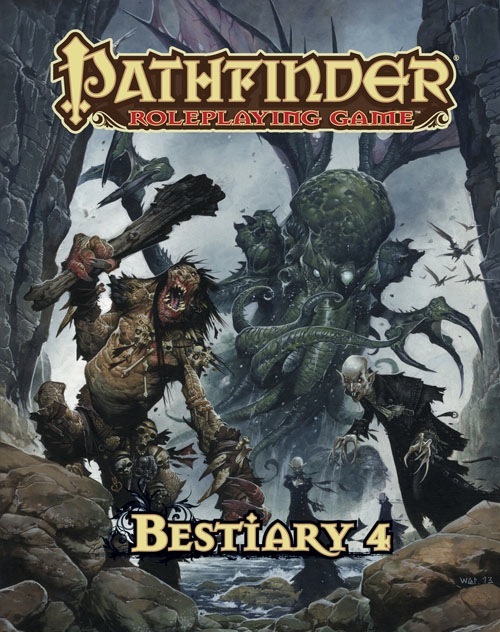Listen, this is a book with Cthulhu, Grendel and a bunch of nosferatus on the cover; you tell me whether or not you think this book is going to be awesome.
Okay, okay, since I can’t really just write a one-sentence-with-a-semi-colon as a review, I guess I will tell you: Pathfinder Bestiary 4 is in fact as awesome as you would guess that a book with a Lovecraftian horror, an Old English poetry reference and nod to German Expressionist films on the cover would be. I’ve seen what Pathfinder can do with its Bestiaries a few times before, and this keeps of the tradition of delivering diverse concepts, interesting mechanics, and enough art and fluff to give even the system neutral reader enough bang for their buck just shopping for inspiration.
One of the things I appreciate about these Bestiaries is there is a always a nice chunk of giving us what we want. Pandering to the cheap seats. The chances are high that a tabletop gamer is also a fan of Godzilla and company, so go ahead and stick a section on Kaiju in there. They make no bones about it; they call ‘em Kaiju and there is a big reptilian one that they call the King of the Kaiju…but it isn’t just a straight knock-off of Godzilla. Rodan Agyra is a two-headed pterodactyl that is lives at the eye of a Hurricane and sure, Mogaru has a fiery breath weapon, but he’s also susceptible to music, giving him a bit of a Pied Piper or Mothra twist.
The twists are what make the Kaiju fun, but in another display of delivering what the reader wants, Bestiary 4 has more than a smattering of Lovecraftian monsters, and or them, it is a matter of translation, of convincing us that yes, this really is the star-thing described by H.P Lovecraft or one of his inheritors. Take the Mi-Go, one of my favorites, whose Evisceration (Ex) power gives them a in-play mechanic to evoke their brain stealing. Or the Nightguants Faceless (Ex) and Tickle (Ex) turned from descriptive traits into descriptive mechanics.
Cthulhu is the big icon in the book, listed under Great Old One, Cthulhu. He weighs in at CR 30, with powers like the nightmare telepathy of Dreams of Madness (Su), Non-Euclidian (Ex) and an Immortality (Ex) power that mimics the gross oil-slick popped balloon Cthulhu from the end of the eponymous story. Oh and of course, you know, Teantacles (Ex).
When Wizards of the Coast gave us Cthulhu’s stats in the d20 Call of Cthulhu there was the anecdote floating around that Monte Cooke’s group use a group of 20th level Iconics—Lidda, Krusk, Ember, etc—to fight him. If one died, they just brought in a fresh 20th level character. In the end, Cthulhu ate thirteen of them before someone managed to imprison him with magic, trapped in hibernation underground. I want to get a bunch of 20th level Pathfinder Iconics—Imrijka, Seelah, Lirianne, etc—and do the same thing with old squiddy here, see what happens.
One thing I enjoy about all creature collections is when they pull from a diverse body of mythology and pop culture; heck, this has been true from the very earliest days of Dungeons and Dragons. Bestiary 4 keeps up the tradition. I remember a friend of mine from Barbados explaining the Soucouyant to me, the vampire witch that takes off her skin and bursts into flame, so it’s nice to see her show up under Hag, Blood. Xenopterids…isn’t that what the monster movie Jeepers Creepers was about? Mieville’s cactus people show up, and so do horse-monsters from Philippine legends. Qallupilluk come from Inuit folklore but their child-snatching ways now seem…well, aboleth-y. Sure the terror bunny that is Almiraj might cause you to shout “run away!” but its pedigree goes past Python and into Islamic poetry. Sugar skull Psychopomps based on La Calavera Catrina, Japanese ghost stories, cenobite Kytons; Bestiary 4 pulls from all over.
Then there is just the miscellaneous odds and ends. A wizard with an Archaeopteryx? That is exactly what I’m into! Space dragons, gremlins—I don’t “get” gremlins—a mythic monster called Drakainia that is like a cross between Zuggtmoy and the xenomorph hive queen, a gearghost that doubles as a way to explain why all the traps in the dungeon are set and kept up, it goes on and on. Speaking of mythic monsters, there are a few here; “mythic” being Pathfinder’s new “epic at any level” expansion, but it seems to me that if you wanted to ignore that angle entirely, it would be easy to take them out. The Rube Goldberg machine that is cascading monster mechanics would still work.
I mentioned system neutral readers; heck, I’m one myself, as I currently use the World of Darkness. I always find books of beasts to be of great use, even if I’m not actually using the system in question at the moment. Interesting art and monster background alone can provide you with enough of a hook to build anything from a room to an adventure to an entire campaign. Not to mention there are true “wtf” monsters like the Vouivre, which is a…dragon with a mermaid for a tail…or the Galvo, which is a…roughly humanoid swarm of electric eels?
Beyond that though, I always scan down to the Special Abilities part of each entry; the ad hoc nature of Special Abilities means they are usually a bit of a mini-game, just the sort of kick an encounter needs. The evil tree Jinmenju will enchant you into eating its poisonous fruit, and has an unsettling drone; the tooth fairy does attribute damage—Charisma by tearing out your teeth, Dexterity by pulling out your fingernails—and it explodes into glittering tear gas when you kill it. You don’t need to play Pathfinder to use those rules or some loose adaptation of them in your campaign.
Pathfinder Bestiary 4 is available now from Paizo
You can find Mordicai Knode on Tumblr and Twitter.










